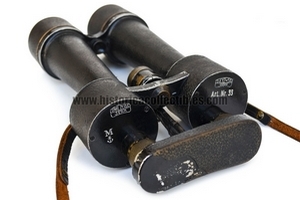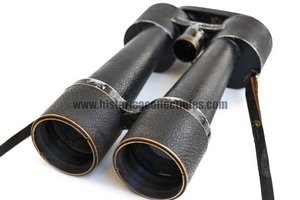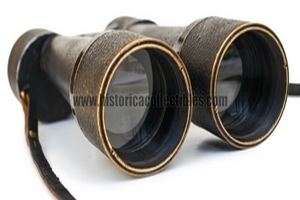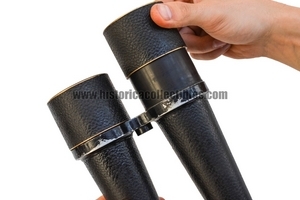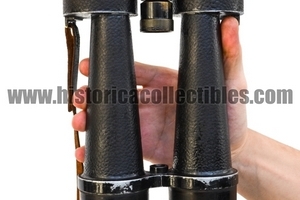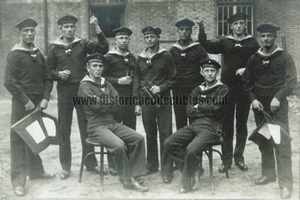Doppelfernrohr 12x50 Carl Zeiss Reichsmarine 1919 Weimar Republic, 1914
Doppelfernrohr 12x50 produced by Carl Zeiss Jena in 1914 and reused, after the 1st World War, by the Reichsmarine of the Weimarer Republik (Weimar Republic). It was intended for the Artillery departments as on the right eyepiece plate, in addition to the information relating to the 12x50 format and the serial number 400402 which places it as a product in 1914, there is the writing "Art. Nr. 33" or Artillery and the Nr 33, in all probability, referable to an assignment.
On the left eyepiece plate, in addition to the Carl Zeiss Jena logo, there is the letter "M" for Marina with the Anchor of the Weimarer Republik underneath.
In fact, this very rare binoculars are a very important historical testimony to the events that followed the 1st World War. In fact, with the Treaty of Versailles stipulated within the Paris Peace Conference of 1919-1920 and signed by 44 States, on 28 June 1919, in Versailles, divided into 16 parts and composed of 440 articles, the German peace delegation he accepted heavy army reductions, heavy war reparations payments, and the so-called "Germany was solely responsible for the outbreak of war" clause.
The Treaty of Versailles, in addition to abolishing conscription for Germany, also placed major limitations on the German armed forces, which were not to exceed 100,000 units and a drastic reduction in the production of war material.
In fact, it was only in 1921 that Carl Zeiss of Jena managed to circumvent the restrictions imposed in the Treaty of Versailles, which did not allow Germany to produce war material for its army (article 168-170 imposed rigorous controls on the production of material war and the consequent export) moving the production of binoculars and optics to Gravenhage in the Netherlands, founding the Zeiss-Nedinsco System.
It is a fact that these binoculars were produced in 1914 and, however, not having the Nedinsco brand, are classified as having been reused by the Weimar Combat Navy: in fact the "M with Anchor" and "Art. Nr. 33" brands were affixed between 1919 and 1920 within Carl Zeiss, which was able to supply the Weimar Navy (crippled due to the restrictions of the Treaty of Versailles), reusing very high quality war material already left over from the 1st World War.
There is the aluminum benutzer covered in leather and the shoulder strap also in leather.
The extraction of the 2 rain cover tubes occurs very fluidly and with great simplicity, the focus is very smooth and precise and the view is truly amazing, sharp and collimated.
Carl Zeiss takes its name from its founder, Carl Zeiss, who on November 17, 1846 chose the small town of Jena, in Thuringia, as the location for his precision optical equipment factory. Thanks to the severe quality control that Carl Zeiss imposed on his products, going so far as to personally destroy the microscopes that did not pass the tests, the newly formed Zeiss became the official supplier of the University of Jena and received the gold medal of the industrial exhibition in 1861 of Thuringia as the best research instrument produced in Germany, awarded to the Stand I microscope of 1857. In 1866 the thousandth microscope was produced and the name Zeiss became known in all European scientific circles. Thanks to studies on the Porro prism, in 1893 Abbe patented double prism binoculars, which accentuated the perception of depth.
The mass production of Zeiss binoculars began in 1894, already at the beginning of the twentieth century more than 30,000 were made, at the beginning of the First World War the quota had risen to 500,000 and, at the end of the Second World War, as many as 2,260,000 were produced binoculars for the civil and military market. Models were made starting from 4x11 mm to 12x40 mm, up to real giants such as the 80 mm and 100 mm. Thanks to studies conducted on the perception of light in low light situations, it was demonstrated that the average dilation of the pupil in an adult is approximately 7 mm. For this reason, the 7x50 mm model was introduced in 1910 and remained on the market until 1917 with few changes to the materials used.
In 1926, following the post-war crisis of the First World War with the Treaty of Versailles which bankrupted many important German companies, Zeiss purchased "C.P. GOERZ" and founded Zeiss Ikon in 1926. In 1937 Zeiss had commercial contacts and factories in more than 29 countries around the world. From '33 Zeiss acquired interest from the Nazi regime, which balanced production towards military instruments. It successfully produced binoculars with wide-angle optics for military use, pressure-resistant optical systems for U-boats, periscope binoculars for targeting tanks. Furthermore, Zeiss cameras were mounted on the V2s for remote sensing operations of the English coasts.
On 1 November 1935, Zeiss, in the figure of Alexander Smakula, patented a process for the treatment of optical glass with extraordinary results in terms of light transmission. Remained a military secret until 1939, it was adopted on binoculars to reduce ghost images and internal reflections. During the Second World War, there were numerous bombings against the Zeiss factories.
Jena was bombed several times by the Allies starting in 1944. Stuttgart was razed to the ground, although the Contessa-Nettel factory suffered little damage. The bombing of Dresden, in addition to devastating the city, also caused considerable damage to the Zeiss Ikon headquarters.
On April 13, 1945, American military forces entered Jena, surprising themselves that the bombing had not caused any significant damage. The main planetarium was in ruins, while the factories remained operational.

